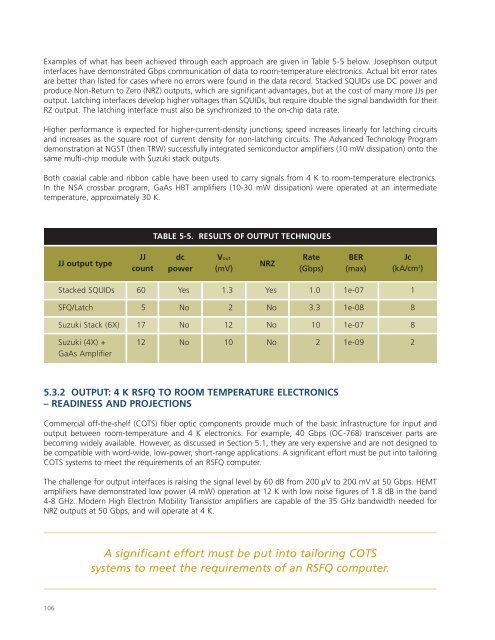Superconducting Technology Assessment - nitrd
Superconducting Technology Assessment - nitrd
Superconducting Technology Assessment - nitrd
You also want an ePaper? Increase the reach of your titles
YUMPU automatically turns print PDFs into web optimized ePapers that Google loves.
Examples of what has been achieved through each approach are given in Table 5-5 below. Josephson output<br />
interfaces have demonstrated Gbps communication of data to room-temperature electronics. Actual bit error rates<br />
are better than listed for cases where no errors were found in the data record. Stacked SQUIDs use DC power and<br />
produce Non-Return to Zero (NRZ) outputs, which are significant advantages, but at the cost of many more JJs per<br />
output. Latching interfaces develop higher voltages than SQUIDs, but require double the signal bandwidth for their<br />
RZ output. The latching interface must also be synchronized to the on-chip data rate.<br />
Higher performance is expected for higher-current-density junctions; speed increases linearly for latching circuits<br />
and increases as the square root of current density for non-latching circuits. The Advanced <strong>Technology</strong> Program<br />
demonstration at NGST (then TRW) successfully integrated semiconductor amplifiers (10 mW dissipation) onto the<br />
same multi-chip module with Suzuki stack outputs.<br />
Both coaxial cable and ribbon cable have been used to carry signals from 4 K to room-temperature electronics.<br />
In the NSA crossbar program, GaAs HBT amplifiers (10-30 mW dissipation) were operated at an intermediate<br />
temperature, approximately 30 K.<br />
TABLE 5-5. RESULTS OF OUTPUT TECHNIQUES<br />
JJ output type<br />
JJ<br />
count<br />
dc<br />
power<br />
Vout<br />
(mV)<br />
NRZ<br />
Rate<br />
(Gbps)<br />
BER<br />
(max)<br />
Jc<br />
(kA/cm 2 )<br />
Stacked SQUIDs 60 Yes 1.3 Yes 1.0 1e-07 1<br />
SFQ/Latch 5 No 2 No 3.3 1e-08 8<br />
Suzuki Stack (6X) 17 No 12 No 10 1e-07 8<br />
Suzuki (4X) + 12 No 10 No 2 1e-09 2<br />
GaAs Amplifier<br />
5.3.2 OUTPUT: 4 K RSFQ TO ROOM TEMPERATURE ELECTRONICS<br />
– READINESS AND PROJECTIONS<br />
Commercial off-the-shelf (COTS) fiber optic components provide much of the basic infrastructure for input and<br />
output between room-temperature and 4 K electronics. For example, 40 Gbps (OC-768) transceiver parts are<br />
becoming widely available. However, as discussed in Section 5.1, they are very expensive and are not designed to<br />
be compatible with word-wide, low-power, short-range applications. A significant effort must be put into tailoring<br />
COTS systems to meet the requirements of an RSFQ computer.<br />
The challenge for output interfaces is raising the signal level by 60 dB from 200 µV to 200 mV at 50 Gbps. HEMT<br />
amplifiers have demonstrated low power (4 mW) operation at 12 K with low noise figures of 1.8 dB in the band<br />
4-8 GHz. Modern High Electron Mobility Transistor amplifiers are capable of the 35 GHz bandwidth needed for<br />
NRZ outputs at 50 Gbps, and will operate at 4 K.<br />
A significant effort must be put into tailoring COTS<br />
systems to meet the requirements of an RSFQ computer.<br />
106














